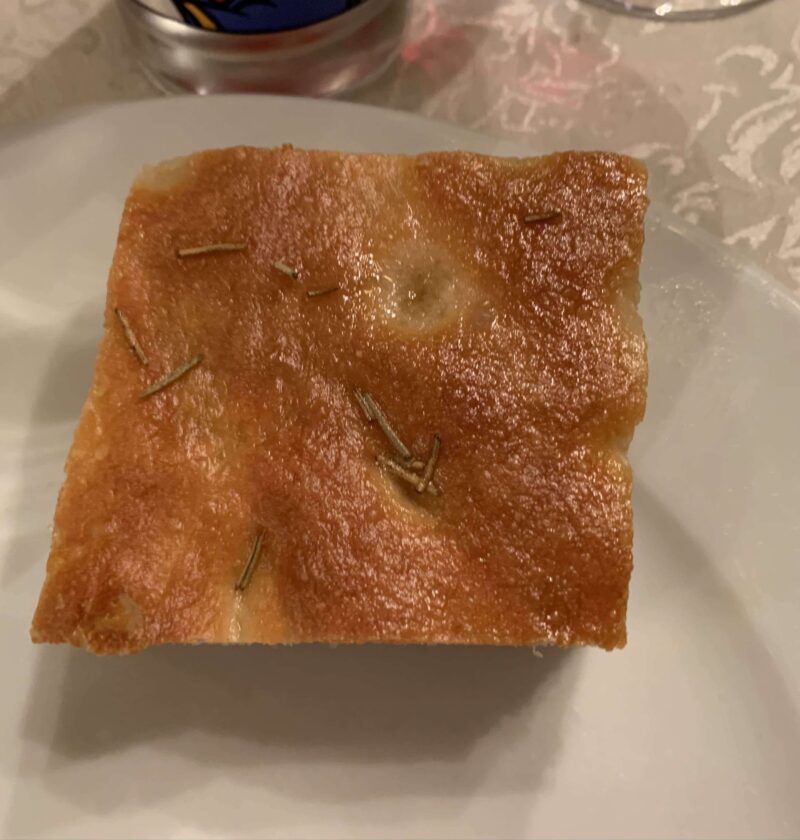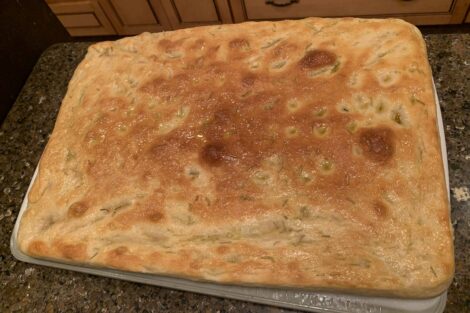
Focaccia is a very old and traditional staple of Italian cuisine. There are hundreds of ways to make this simple bread but its main ingredients are flour and extra virgin olive oil. This recipe is what my Nonna would cook every Sunday so that we would have bread for sandwiches that week. The bread itself is light and fluffy but with a delicate crunch and a salty tingle that pairs easily with any meat, cheese or sauce. I started making this recipe myself in high school and it became a regular product from my own kitchen. One day I went to go make it I found myself without any sugar. That lead me to a standstill on how to make the recipe. Yet after asking my Nonna, she told me to use honey. So here is how I used honey instead of sugar to make a perfect focaccia.
Scroll down to read more about the science below!
If you would like to see the recipe in a different format click here!
Science Behind the Ingredients-
- Flour- Semolina Flour: Semolina is richer in protein and has a higher satiating power. It also has more carotenoids (which give it a more yellow color) which are great antioxidants that are very useful in eliminating free radicals. Double 00 Flour: Double 00 is a soft wheat flour which is similar to All Purpose Flour however it is more finely ground.
- Yeast- The yeast in this recipe is used to make the dough rise by releasing CO2 from the sugar in the recipe and in the flour. Yeast also adds a distinct flavor and scent of the bread.
- Extra Virgin Olive Oil- The Extra Virgin Olive Oil is responsible for the puffed interior but also necessary to achieve the golden brown, slightly crispy, exterior of the focaccia. (The better quality of olive oil, preferably extra virgin, the better the focaccia will taste)
- Honey- The exchange of honey for sugar in this bread can be an equal substitution. The use of honey in this recipe is to act as the sugar to activate the yeast. For my experiment I used Orange Blossom honey which has proportionally less glucose than fructose which helps keep it from crystallizing, as that is not what we want for this recipe.
- Water- The water in this recipe helps to proof the yeast and adds moisture to the bread. Also by adding in the flour and water together it is able to create the gluten in the bread and create a chewy dough.
- Salt- The use of salt in this recipe not only adds the distinct salty flavor of the bread but is also important in controlling the yeast as well. The salt balances the yeast activity and allows the yeast to leave some of the sugar in the bread so that it can caramelize in the oven and create a darker crust.
Science Behind the Steps-
- The first step is the process of activating the yeast, by combining the yeast, honey and water in a bowl. I always deem this step necessary to test the vitality of the yeast and to see if it is beginning to rise.
- Then when adding in the flour and oil the activated yeast begins to feed on the sugar in the flour. This process allows the yeast to begin to consume the sugars in the flour and start to react and the EVOO helps keep it at a controlled pace. Also in this step the water and the flour combine to begin forming the gluten needed for the focaccia.
- By adding salt last it tightens the gluten structure and adds strength to the dough. Then the dough should seize up into a more typical bread dough.
- Using EVOO to cover the sides of the bowl before transferring allows the dough to incorporate the oil into itself as it rises and grows. The EVOO in particular helps keep the yeast from overtaking the recipe as well.
- By covering the dough and leaving it to sit for 2 hours, the yeast in the dough is reacting with the sugar from the honey and the flour to release CO2 which causes the dough to rise.
- Scraping and flattening the dough into the pan allows the gluten to stretch after it had risen. Stretching it flat gives us the shape of the dough that we want to achieve, the flat bread. By adding dimples across the surface it gives the dough a way to cook evenly when it gets to the oven by having dimples where the heat can cook it through all of the way.
- As the dough rises again, it bubbles around the brine to soak it all into the bread giving the bread a more complex flavor.
- When cooking the focaccia in the oven, it is being cooked by convection. Cooking with convection means that the warm air is able to cook the focaccia evenly from all sides. This helps the bread to be cooked at the same time uniformly. Rotating the pan is another way to make sure the bread is cooking evenly, in case your oven has a hot spot in the back or front.
Ingredients
-
Dough
- Brine & Garnish
Instructions
- Whisk together yeast, honey and water in a medium bowl. Let it sit for 5-10 minutes until it looks foamy and bubbly.
- Use a dough hook to stir in the flour and 2 tablespoons of olive oil mixing until the flour is completely moistened.
- Add salt and knead until the dough begins to tighten up and then relaxes.
- Rub 2 tbsp olive oil all around large mixing bowl and transfer dough to oiled bowl flipping once to coat completely with oil. Cover with plastic wrap and let sit until doubled in size (about 2 hours)
- Pour remaining 1/4 cup of olive oil into bottom of a rimmed baking sheet. Use your hands to evenly distribute the olive oil among the bottom and the sides.
- Scrape the dough into the baking sheet, flattening it slightly with your hands. Flip the dough once and gently stretch it to fit into an even layer in the baking sheet. (if the dough has not stretched out yet let it rest 10 minutes and re-stretch) Use your fingertips to make dimples in the dough.
- Dissolve kosher salt in 1/3 cup warm water drizzle over surface of the focaccia letting it pool in the dimples.
- Cover loosely with plastic wrap that has been lightly sprayed with nonstick cooking spray. Let sit in a warm place for 45 minutes to relax and rise again.
- Preheat the oven to 450 degrees F
- Remove the plastic wrap from the dough and sprinkle with flaky sea salt.
- Bake for 30 or 35 minutes, rotating the baking sheet once halfway through, until the focaccia is deep golden brown on the top and bottom.
-
Drizzle with olive oil and let sit for 5 minutes. Then move the focaccia to a wire rack to cool completely.

Notes
The recipe used is adapted from family tradition.
Photos taken by myself.
Cordes, N. (2010). Cooking with Honey. In M. BERENBAUM (Ed.), Honey, I’m Homemade: Sweet Treats from the Beehive across the Centuries and around the World (pp. 17–22). University of Illinois Press. http://www.jstor.org/stable/10.5406/j.ctt3fh64q.5
Frankel. (2011). Nutritional and Biological Properties of Extra Virgin Olive Oil. Journal of Agricultural and Food Chemistry, 59(3), 785–792. https://doi.org/10.1021/jf103813t
Kiszonas, Ibba, M. I., Boehm, J. D., & Morris, C. F. (2021). Effects of the functional Gpc‐B1 allele on soft durum wheat grain, milling, flour, dough, and breadmaking quality. Cereal Chemistry, 98(6), 1250–1258. https://doi.org/10.1002/cche.10477
Provost, Colabroy, K. L., Kelly, B. S., & Wallert, M. A. (2016). The Science of Cooking: Understanding the Biology and Chemistry Behind Food and Cooking. John Wiley & Sons, Incorporated.
Oladunmoye, Aworh, O. C., Maziya‐Dixon, B., Erukainure, O. L., & Elemo, G. N. (2014). Chemical and functional properties of cassava starch, durum wheat semolina flour, and their blends. Food Science & Nutrition, 2(2), 132–138. https://doi.org/10.1002/fsn3.83
Thanhaeuser, Wieser, H., & Koehler, P. (2014). Correlation of Quality Parameters with the Baking Performance of Wheat Flours. Cereal Chemistry, 91(4), 333–341. https://doi.org/10.1094/CCHEM-09-13-0194-CESI